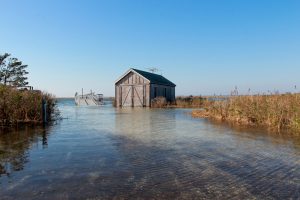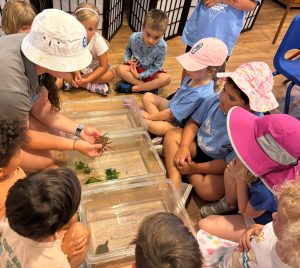by Elizabeth Hefner, Development Team
 Today, the threats to the marsh look different than they did in 1965. While development pressures continue to be a danger, now the impacts most acutely felt are from rapidly rising seas. They manifest as the increased frequency and intensity of coastal storms, nuisance sunny-day flooding, and continued species decline. At The Wetlands Institute, we are actively committed to discovering, developing, and implementing solutions to address these complex threats.
Today, the threats to the marsh look different than they did in 1965. While development pressures continue to be a danger, now the impacts most acutely felt are from rapidly rising seas. They manifest as the increased frequency and intensity of coastal storms, nuisance sunny-day flooding, and continued species decline. At The Wetlands Institute, we are actively committed to discovering, developing, and implementing solutions to address these complex threats.
New Jersey is now a national leader in marsh restoration through sediment addition because of the know-how of the partners in the Seven Mile Island Innovation Lab – The US Army Corps of Engineers, NJ DEP, and The Wetlands Institute – and the tools we’ve developed right here. We have studied how these marshes are changing and how best to help them, and have successfully created strategies to restore them.
We are making great strides, documenting the needs of sensitive species and working to reduce impacts to them. Research projects are banding and tracking Great Egrets and Black-crowned Night Herons, studying the habitat needs of American Oystercatchers, and tracking Black Skimmers through banding and telemetry studies. We have also been addressing the plight of diamondback terrapins for more than 30 years and are developing a better understanding of their needs and contributing to efforts to help.
 Institute teams are advancing essential conservation programs. To date, the efforts of TWI staff and volunteers through our reTURN the Favor program have saved over 1,000,000 horseshoe crabs. The marsh is not just our laboratory; it’s our classroom. Nearly 17,000 children and young adults participated in formal education programs with The Wetlands Institute last year.
Institute teams are advancing essential conservation programs. To date, the efforts of TWI staff and volunteers through our reTURN the Favor program have saved over 1,000,000 horseshoe crabs. The marsh is not just our laboratory; it’s our classroom. Nearly 17,000 children and young adults participated in formal education programs with The Wetlands Institute last year.
You, our friends and donors, are an essential part of making our work possible. Your support allows us to solve complex problems, create change, and hope for the future of our marshes. Thank you.
